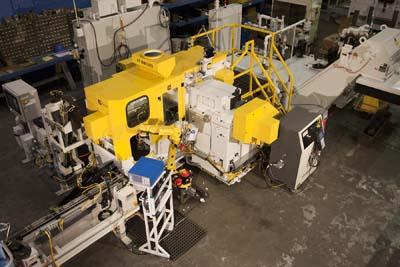
C & B Machinery has improved productivity and flexibility of their double disc non-coplanar connecting rod grinding system first introduced in 2009 for the Chevrolet Volt 1.4L auxiliary engine. The first grinding system produced a stepped connecting rod from a parallel (or coplanar) rod. The 1.4L Chevy Volt connecting rod has a 1.2mm symmetrically smaller crankshaft end width, and both the pin and crank ends of the rod are ground in one sequence. At the time, the system was considered the most advanced double disc grinder ever produced by C & B.
This latest system, recently shipped to Eston Manufacturing Division of Linamar Corp., is grinding a 1.8L connecting rod with a symmetrical reduction of the pin end of 3.8mm. As before, the challenge was to produce this part from a coplanar connecting rod in one operation. Stock removal from the pin end of the connecting rod is 5mm and stock removal from the crank end is 1mm. Previously, this connecting rod required three grinding operations to complete and the crank and pin end were ground on two separate machines.
C & B's application engineers took the challenge to task developing a special tooling package and unique 2-stage grinding cycle which first rough grinds the pin end to a stock condition equal to the crank end. It then finish grinds the crank and pin end of the connecting rod simultaneously. Grinding the crank and pin ends at the same time produces much better symmetry between the two.
Additionally, the grinder easily exceeds Eston's 1.67 Ppk requirements for size, parallel and flatness. The grinding system also includes a post process gaging system with automatic feedback to the grinding wheel infeed servos providing automatic compensation for wheel wear. The gage also inspects step relationship between the crank and pin end faces.
The C & B model DG-2H-30/SA Connecting Rod grinding system has the ability to grind parallel parts, non-coplanar parts, pin end only or crank end only configurations with very simple changeover. This bodes well with today's manufacturing requirements — lower production rates, better flexibility and a never-ending demand for lower machining costs per piece. With models utilizing up to 42" diameter grinding wheels, large diesel connecting rods can also be produced in this manner.
Contact Details
Related Glossary Terms
- grinding
grinding
Machining operation in which material is removed from the workpiece by a powered abrasive wheel, stone, belt, paste, sheet, compound, slurry, etc. Takes various forms: surface grinding (creates flat and/or squared surfaces); cylindrical grinding (for external cylindrical and tapered shapes, fillets, undercuts, etc.); centerless grinding; chamfering; thread and form grinding; tool and cutter grinding; offhand grinding; lapping and polishing (grinding with extremely fine grits to create ultrasmooth surfaces); honing; and disc grinding.
- grinding wheel
grinding wheel
Wheel formed from abrasive material mixed in a suitable matrix. Takes a variety of shapes but falls into two basic categories: one that cuts on its periphery, as in reciprocating grinding, and one that cuts on its side or face, as in tool and cutter grinding.
- parallel
parallel
Strip or block of precision-ground stock used to elevate a workpiece, while keeping it parallel to the worktable, to prevent cutter/table contact.

